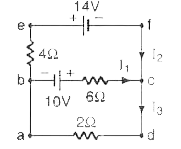चित्र 6.38 में दिखाए परिपथ में धाराएं I1,I2 और I3 निकालें । बिन्दुओं b और c के बीच विभवान्तर भी निकालें।

The correct Answer is:I1=2A,I2=−3A,I3=−A,Vb−Vc=2V
Step by step video, text & image solution for चित्र 6.38 में दिखाए परिपथ में धाराएं I_(1), I_(2) और I_(3) निकालें । बिन्दुओं b और c के बीच विभवान्तर भी निकालें। by Physics experts to help you in doubts & scoring excellent marks in Class 12 exams.
Updated on:21/07/2023Topper's Solved these Questions
- विद्युत परिपथ , विद्युत ऊर्जा और शक्ति BOOK - GRB PUBLICATION HINDICHAPTER - विद्युत परिपथ , विद्युत ऊर्जा और शक्ति EXERCISE - विषय - आधारित अभ्यास ( पोटेंशियोमीटर )
6 Videos
- विद्युत परिपथ , विद्युत ऊर्जा और शक्ति BOOK - GRB PUBLICATION HINDICHAPTER - विद्युत परिपथ , विद्युत ऊर्जा और शक्ति EXERCISE - विषय - आधारित अभ्यास ( विद्युत ऊर्जा , शक्ति और जूल का नियम )
9 Videos
- विद्युत परिपथ , विद्युत ऊर्जा और शक्ति BOOK - GRB PUBLICATION HINDICHAPTER - विद्युत परिपथ , विद्युत ऊर्जा और शक्ति EXERCISE - प्रश्नोत्तरी : 5 अंक
3 Videos
- प्रत्यावर्ती धाराएँ BOOK - GRB PUBLICATION HINDICHAPTER - प्रत्यावर्ती धाराएँ EXERCISE - रिक्त स्थान भरना
15 Videos
- वैद्युत क्षेत्र और गाउस नियमBOOK - GRB PUBLICATION HINDICHAPTER - वैद्युत क्षेत्र और गाउस नियमEXERCISE - NCERT पाठ्यपुस्तक अभ्यास : उत्तरो सहित
29 Videos
Similar Questions
1 m लम्बी पोटेंशियोमीटर तार का प्रतिरोध 10Ω है। यह एक प्रतिरोध तथा 2V विधुत वाहक बल और नगण्य प्रतिरोध वाली बैटरी के साथ श्रेणीक्रम में जोड़ी जाती है। एक स्रोत को , जिसका विधुत वाहक बल 10 m V है, पोटेंशियोमीटर तार की 40 cm लम्बाई से संतुलित किया जाता है। बाहरी प्रतिरोध का मान क्या है ?
View Solution5.0 A की धारा 44Ω प्रतिरोध वाली बिजली की इस्तरी से गुजरती है। इस्तरी द्वारा 5 मिनट के खपत की गई ऊर्जा निकालें।
View Solutionवैद्युत परिपथों के किरखोफ नियम बताएँ और इनका प्रयोग करते हुए व्हीटस्टोन ब्रिज का सिद्धान्त निकाले।
View Solutionएक शुद्ध प्रेरकत्व में क्षयित हुई औसत शक्ति.........।
View Solutionहवा में एक दूसरे से 30 cm दूर रने 2×10−7C और 3×10−7C आवेश वाले दो छोटे आवेशित गोलों के बीच बल ज्ञात करें।
View SolutionIfI1=∫102x2,I2=∫102x3dx,I3=∫212x2dx,I4=∫212x3dx, then which of the following is/are true? I1>I2 (b) I2>I1 I3>I4 (d) I3<I4
View SolutionIf I_(1)=int_(x)^(1)(1)/(1+t^(2))dt and I_(2)=int_(1)^((1)/(2))(1)/(1+t^(2))dt for x>=0 then (A) I_(1)=I_(2)(B)I_(1)>I_(2)(C)I_(1)
View SolutionIf I_(1),I_(2),I_(3) are excentres of the triangle with vertices (0,0),(5,12),(16,12) then the orthocentre of Delta I_(1)I_(2)I_(3) is
View SolutionIn the study of transistors as an amplifier, if α=Ic/Ic and β=Ic/Ib, where Ic,Ib and Ie are the collector, base and emitter currents, then
View SolutionThe moment of inertia of thin square plate ABCD of uniform thickness about an axis passing through the center O and perpendicular to the plane of the plate is ( i ) I_(1)+I_(2) ( ii ) I_(2)+I_(4) ( iii ) I_(1)+I_(3) ( iv ) I_(1)+I_(2)+I_(3)+I_(4) where I_(1) , I_(2) , I_(3) and I_(4) are repectively moments of inertia about axes 1 , 2 , 3 and 4 which are in the plane of the plane
View SolutionConsider a uniform square plate shown in the figure. I_(1), I_(2), I_(3) and I_(4) are moment of inertia of the plate about the axes 1, 2, 3 and 4 respectively. Axes 1 and 2 are diagonals and 3 and 4 are lines passing through centre parallel to sides of the square. The moment of inertia of the plate about an axis passing through centre and perpendicular to the plane of the figure is equal to which of the followings. (a) I_(3) + I_(4) (b) I_(1) + I_(3) (c) I_(2) + I_(3) (d) (1)/(2) (I_(1) + I_(2) + I_(3) + I_(4))
View SolutionFind relation in between current i_(1), i_(2), i_(3), i_(4), i_(5)" and "i_(6) .
View Solutionचित्र में दिखाए गए छायांकित क्षेत्र के लिए असामिका है-

View Solutionनिम्नलिखित में से कौन-सी संख्या 45 और 95 के बीच में नहीं है :
View SolutionI,I1,I2,I3 are the in centre and excentres of ΔABC .If I(0,0),I1(2,3),I2(5,7) then the, distance between the orthocentres of ΔII1I3 and ΔI1I2I3is
View Solution
